Fusion Apollo and Signature Series, a boatload of audio goodness
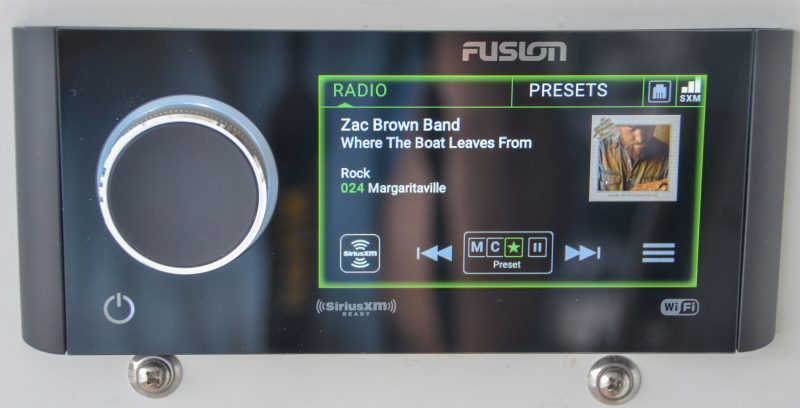
The cockpit Fusion MS-RA770 head unit running in PartyBus mode (as indicated by the green border) from flybridge stereo
A day on the water is better with good tunes, and the rise of streaming has changed how we get music on board a lot. For the last decade, Fusion has lead the way with stereos that use the latest technology to deliver audio on boats. I’ve just finished a complete install of the company’s current gear aboard Have Another Day and as you will read, Fusion continues to leverage the latest tech and deliver great sound.
Fusion has been busy developing products like the all-new Apollo stereos, improved Signature Series speakers, new remotes and even new RCA interconnects. The combination of their head units, amplifiers, speakers, and DSP tuning have made for great sound quality with easy configuration aboard Have Another Day.
The System
- From top to bottom – MS-SRX400, MS-RA670, MS-RA770
- From top to bottom – MS-SRX400, MS-RA670, MS-RA770
Fusion recently unveiled the Apollo MS-RA670 as the middle sibling in their Apollo head unit line. They now have the 1-zone SRX-400 ($350 list), 3-zone MS-RA670 ($450 list), and 4-zone MS-RA770 ($650 list) offering a stereo appropriate for just about any need.
Have Another Day previously had a Fusion UD-650 mounted on the flybridge with an NRX remote control in the cockpit. This time around I installed separate Apollo RA-770 head units in each location, and thus we can listen to different audio in each area or use Fusion’s PartyBus mode to have the same music in both.
Our flybridge is a large area and can be a tough spot to fill with good sound underway with the enclosure wide open. So, with Fusion’s help we selected two 6.5″ SG-CL65SPW Signature Series speakers for the helm area, two 7.7″ SG-CL77SPW Signature Series speakers for the middle portion, and 8.8″ SG-FL88SPWs Signature Series speakers for the aft-most portion of the flybridge. There’s also a 10″ SG-SL101SPW subwoofer paired with the middle set of speakers and each pair of speakers is a separately controlled zone on the 770. Powering it all is a SG-DA82000 8-channel amp.
Our cockpit is smaller so it’s set up with fewer speakers — two 8.8″ Signature Series, two 7.7″, and a 10″ subwoofer — powered by a six-channel SG-DA61500 Signature amplifier. I also spread four MS-ARX70 ANT wireless remotes around the boat for quick adjustments to the two stereos.
Installation
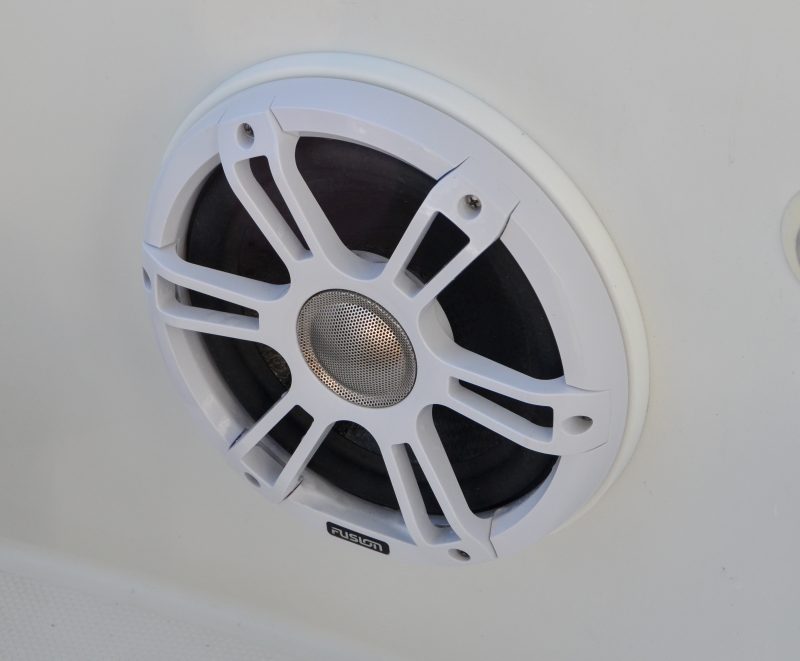
An SG-FL88SPW 8.8″ speaker with a starboard spacer ring to bring the speaker out far enough to avoid hitting the inside of the hull
Installing stereos frequently means enlarging holes for different sized speakers and that often means cutting fiberglass, which isn’t my favorite part of any install. But fortunately I got to reuse existing cutouts for six of the ten speakers and both subwoofers. However, one set was deeper than the ones I was replacing so I ended up having to make a spacer ring out of Starboard to avoid hitting the side of the hull with the back of the speaker (And while Starboard is a mess to cut, a palm router and a piece of bar stock makes for easy and even fairly round circles.)
The MS-RA770 is a little bit smaller than the UD-650 I replaced and the holes don’t lineup. Fortunately, Fusion makes a spacer kit to allow the previous cutout to be used.
The RA770 has both 2.4ghz WiFi and Ethernet connectivity options. The WiFi can act as an access point (and DHCP server) or connect to an existing network, and I initially tried connecting the RA770s to Have Another Day’s network. But on my RF congested boat an acceptable 2.4ghz WiFi connection wasn’t possible, so I connected the radios to the network via Ethernet cables instead. I really wish Fusion included 5ghz WiFi in the radios as I’ve not had these connectivity problems with the higher frequency band.
Using Apollo
DSP
With all the speakers installed and everything wired up, the moment of truth had arrived. I turned everything on and began playing music. I was instantly quite happy though I did notice a little too much bass here or some tinny sound there. But I’d read Ben E.’s entry about the 2018 Apollo launch event and knew there was some DSP (Digital Sound Processing) magic possible. So with my phone linked to each head unit I fired up FusionLink app and navigated to the DSP settings.
The DSP settings on the Apollo head units collect information about the environment in which the stereo is installed (cabin, covered, helm, open air, etc), the speakers connected, the amp connected, the presence of a subwoofer and several additional configuration possibilities. Once that information is provided the app shows you the settings you should be using — if you’re using a Fusion amp — and then gives you a button to send your DSP settings.
There’s a noticeable difference in sound quality once DSP settings have been configured and sent to the stereo. The occasional sound issues I mentioned above were all corrected and replaced with balanced, rich sound. Prior to discovering boating as a way to spend all my money, I used to consider myself something of an audiophile. In those days I would have turned my nose up at anything using DSP to tune sound. But in reality boats are pretty lousy listening environments with odd angles, hard surfaces, open spaces and lots of noise; so DSP can be very helpful in improving the sound quality.
Streaming
Bluetooth has worked reliably for streaming on both iOS and Android devices, but it has a range of about 15-30 feet from the stereo. So I frequently find the audio stuttering if I leave my phone in my pocket and walk around the boat. Airplay on an iOS device works over WiFi, which means that the connection range between the phone and stereo is limited only by the WiFi network range, and that’s usually a good bit further than the 15-30 feet afforded by Bluetooth. I’ve found WiFi streaming on Android devices to be more difficult and it require an additional app to work. But I have noticed that the audio quality is a little better over WiFi on both iOS and Android .
PartyBus
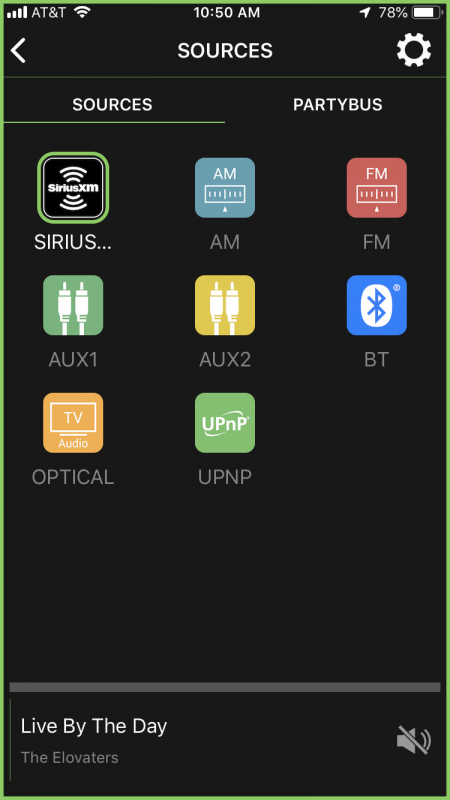
The green border shows that although I’m connected to the cockpit RA770 it is PartyBus linked to the flybridge RA770 so these sources are from the flybridge unit
PartyBus multi-zone audio is one of the most exciting features of Apollo. With PartyBus you can listen to the same audio on multiple Fusion head units connected to the same network. I can connect my phone to the flybridge stereo, start streaming via Bluetooth and then link my cockpit stereo via PartyBus and listen to the same music, perfectly synchronized, in the cockpit as well. I can then go one step further and join my dinghy’s SRX400 stereo to the big boat’s wireless network so we can listen to the same music in the dinghy as long as it is within WiFi range. This may not be practical for us, but I can imagine using PartyBus at an anchorage or sandbar with lots of boats joining via WiFi and all listening to the same music.
Remote Controls Galore
- The Fusion-Link NMEA-2000 control on a Raymarine Axiom 12
- The Fusion-Link NMEA-2000 function running on a Garmin 8612
- Simrad’s NSS EVO12 with the audio panel expanded
- The Fusion-Link App on iOS
- An ARX70 ANT remote at the helm of Have Another Day
- An ARX70 as you enter the cockpit of Have Another Day
With four ARX-70 remote controls (detailed review here) spread around the boat, quick changes to music or volume are right at hand. In addition, the Fusion head units can be more deeply controlled from an MS-NRX300 wired remote (connected via NMEA-2000), from the Fusion-Link app running on phones or tablets, and from nearly all MFDs manufactured in the last five or more years. That’s all illustrated above, and these Fusion stereos can also be controlled by many Garmin watches!
I’ve been wearing a Garmin Quatix 5 Marine Watch for a couple of months now and am really enjoying how I can turn the volume up or down, pause the music, skip tracks and even change inputs right from my wrist. Like the ARX remotes, the Quatix is using the ANT radio built into the watch to communicate with Fusion head units. Also like the ARXs, the radio link between the watch and head unit has proved to be quick and reliable. Unlike Bluetooth, which can be flakey at times, I’ve seen no issues requiring repairing of the connection or anything similar.
Putting it all together
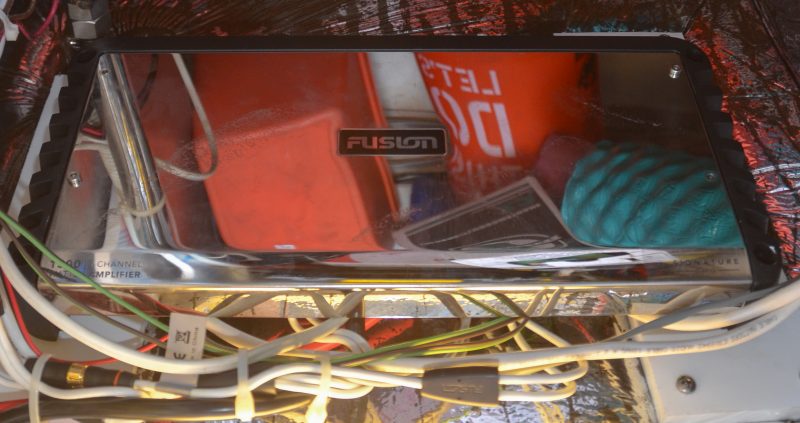
The 6 channel amp powering the cockpit on Have Another Day. The mirror finish shows all the junk in my lazarette
Fusion’s DSP functionality for all of their speakers and amplifiers might be enough reason to purchase an all Fusion stereo system. During my testing I’ve seen the benefits of choosing a single brand of equipment from the head unit to the amplifiers to the speakers. The amplifiers are heavily constructed with generous heat-sinks, easy-to-connect speaker and power terminals, and a lovely mirror polished stainless cover. The speakers sound great and appear very well made, with sizable magnets, durable composite cone material, and LED cone lighting. Fusion’s interconnects utilize directional shielding to minimize noise, so you must pay attention to the arrows on the shield of the cables that indicate the correct direction from head unit to amplifier.
Opportunities for improvement
Overall I’m loving the Apollo and Signature Series system, but that doesn’t mean there aren’t some things I think could be improved. The two areas of greatest concern for me have been network connectivity and noise filtering. I mentioned earlier that I wished Fusion included 5ghz WiFi in the radio since I frequently find 2.4ghz WiFi to be unusable on the boat. The lack of 5ghz WiFi has restricted me to only using the wired connections on all head units. While that’s an initial install hassle it does also result in more robust and reliable connections once the cable is run.
I’ve also spent some time chasing some issues with noise introduced into the system. Despite reinstalling my flybridge stereo in exactly the same place as the UD-650 I removed (and also reusing the same common busbar for the amp and head unit), I encountered quite a few issues with noise between the amp and head unit. That was vastly improved when a power filter was installed prior to the head unit but that wasn’t needed with the previous setup. I’m not sure if that’s a factor of noise filtering in the head unit, in the amps, or something entirely peculiar to my installation. I’ve learned that Have Another Day is a high noise environment in all respects as a result of the sheer quantity of stuff running aboard.
Final Thoughts
Because of the size of the system I installed on Have Another Day and because I added another head unit in a new location this install took me a total of 3-4 days to complete. But, this project breaks down nicely into smaller pieces, which is how I did it. One day I swapped a couple of pairs of speakers, the next I swapped amps, then I worked on the head units. Most of the work was quite easy and I was able to reuse almost all of my existing wiring. I had to run new 4 gauge wires from my house batteries to the new location for the cockpit stereo amp. If you have to run new large power cabling back to your batteries and you’re not familiar with 12v marine wiring practices, I would strongly consider bringing in a pro for that work.
Fusion and their product line have grown quickly since their arrival in the marine marketplace a little over a decade ago with an iPod (remember those) integrated head unit. The installation on Have Another Day and Fusion’s impressive list of manufacturers installing their equipment demonstrate the depth of their line and their ability to compete effectively in the marine audio market.








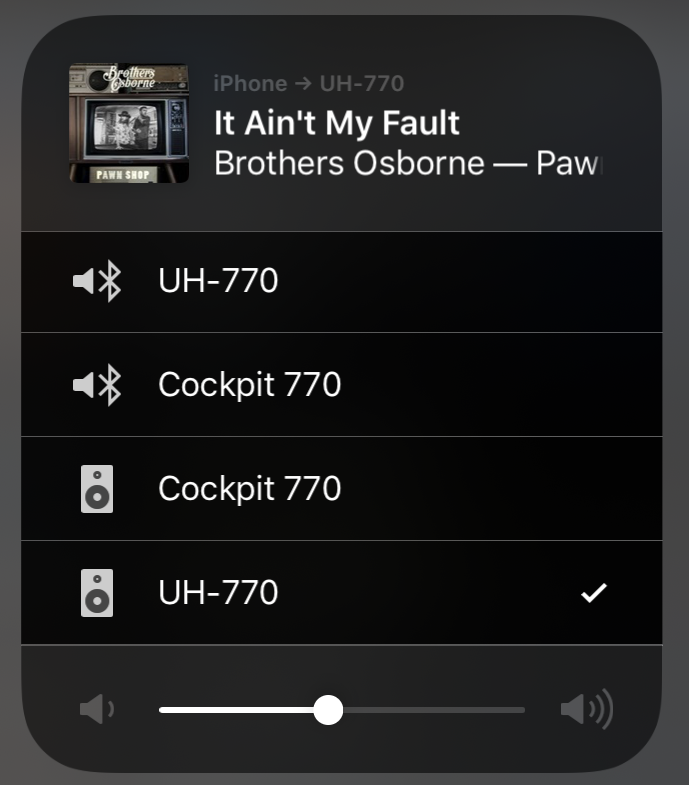








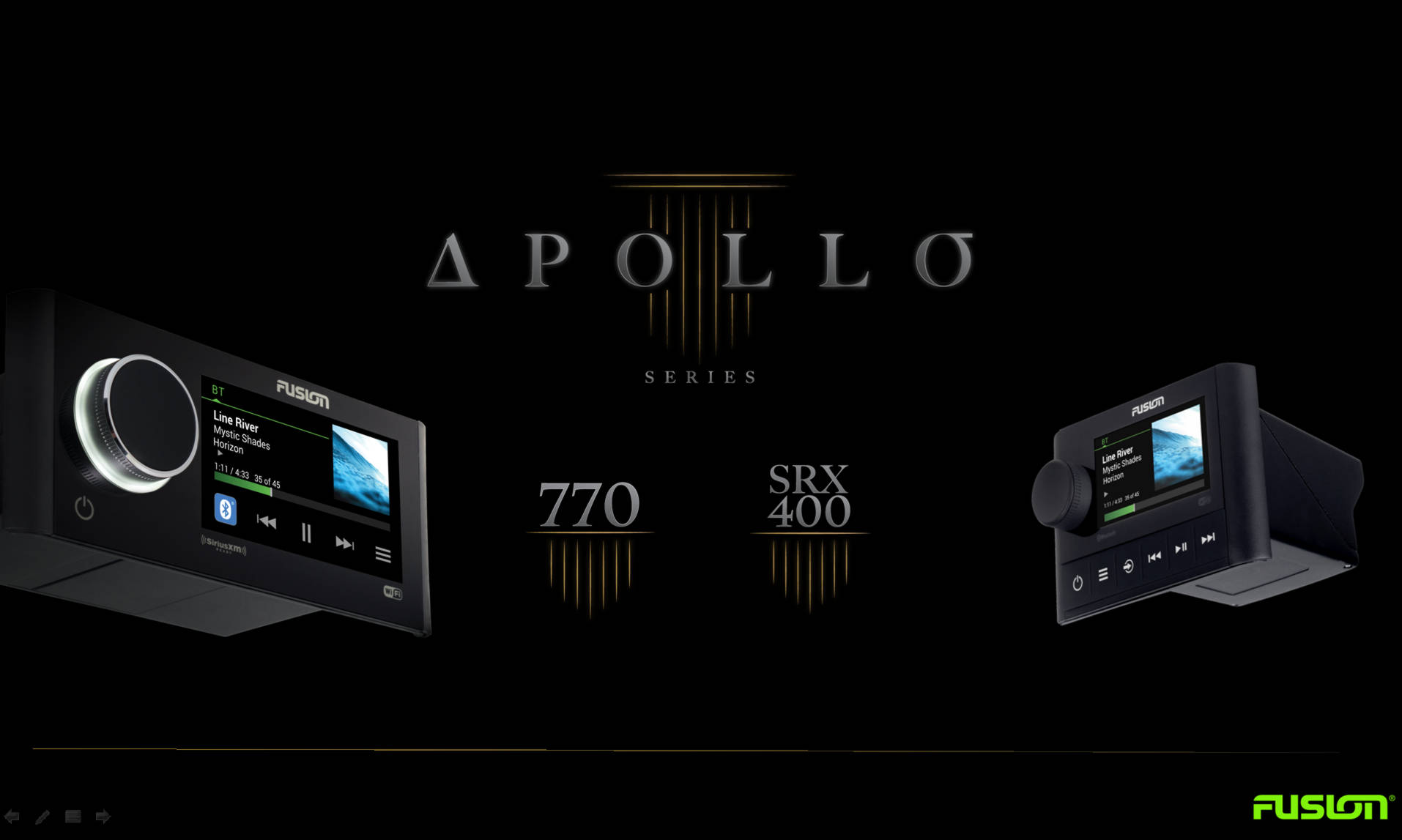


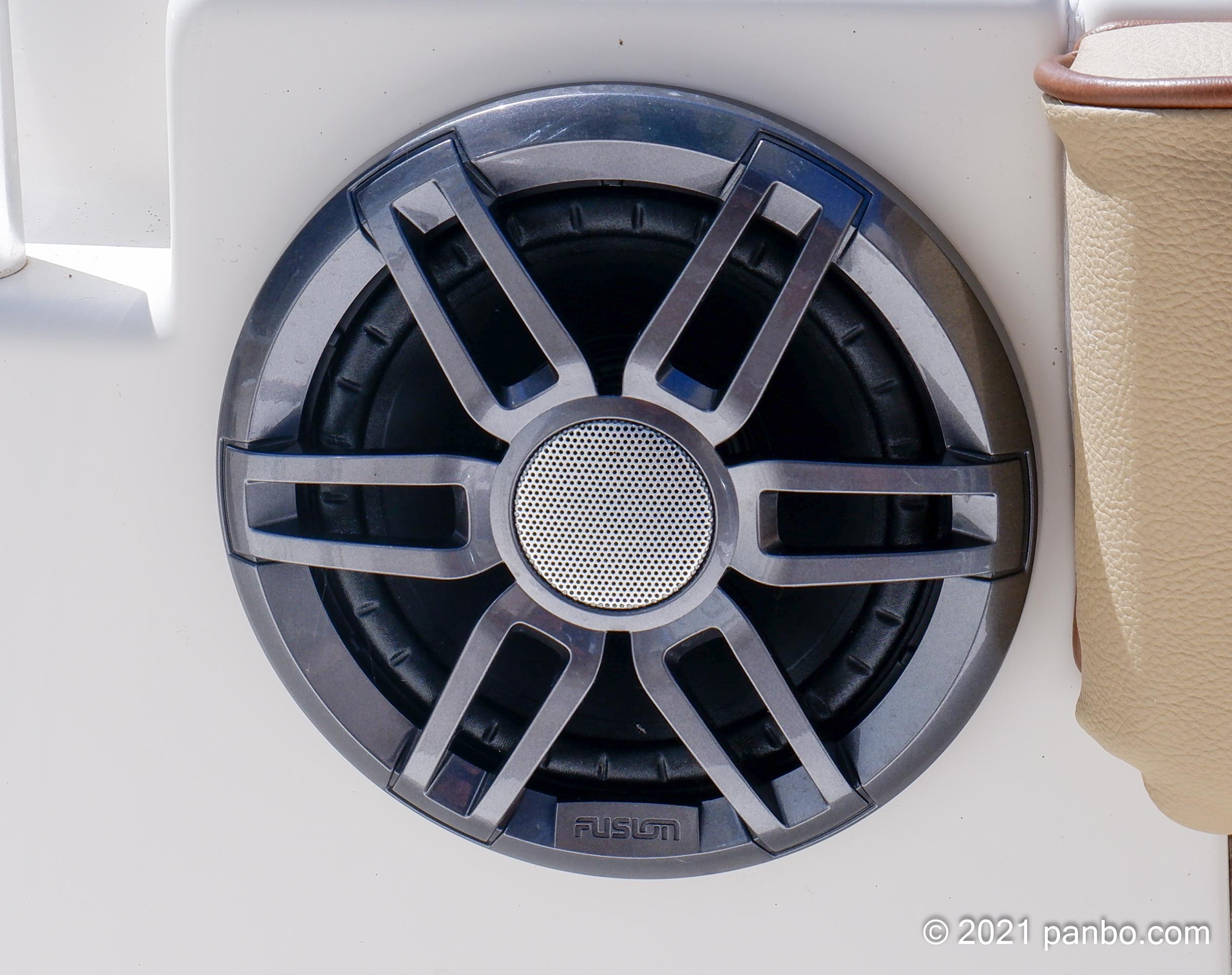







The issue with noise coming through the head unit is interesting. I have a Fusion MS AB206 Subwoofer/Amp that is unusable because it is picking up interference from something on the boat. I have fitted a power filter and high end shielded cables but nothing has worked. Sound equipment for boats and cars should be designed for an electrically noisy environment.
I’d be interested to know if others have experienced similar noise issues. It’s very possible that Have Another Day is so noisy these are unusual issues limited to my boat.
Ben
I have the new Apollo on board and used existing wiring from when my boat was built both for power and also speakers. I haven’t noticed any noise at all so far.
I installed the MS AB206 and it picks up noise from LED lights and AC units. I have not yet tried any filters, but I am sure it is coming from the unit. If I unplug power and use the Fusion radio I have zero interference. Power is coming from the same place of the Fusion radio.
Ipod search functionality is very very poor for a top-of-the-line unit like the MS-RA770. This is what I just sent to support…
I still consider that interface very non-intuitive as somone who has developed quite a few UI’s over the years. It’s a touchscreen and most other functions of the device are triggered by touch actions, so having to go to the encoder to activate a function is IMHO not consistent.
Perhaps I am in the minority still using an Ipod, but when you are sailing outside the range of 3G/4G/cellular service it’s the only way to get music happening.
After your advice to move the encoder knob after starting the filter I did some more testing. Although it works, the search system is really hard to use effectively and I offer the following…
Firstly, allow an anticlockwise rotation on the top level search and scroll back to ‘Z’.
Secondly, numbers are an uncommon start to music titles so instead of separating out 0123456789 just allow a #. In my 10,000-odd song library there are 26 songs and 16 artists that start with a numeral.
‘The’ is definitely a bug when combined with searching for ‘T’. For example, if I want to play my favourite AC/DC song T.N.T. I search for song and ‘T’ and the Fusion takes me to ‘Theme from Rush’ and I have to scroll up through hundreds of songs to get back past all the ‘The’ songs, then it’s another 47 rotations until I finally get to ‘T.N.T.’ which is the first song that starts with T.
For whatever reason I can search for all artists by their first letter except ‘W’, which then finds ‘The Waifs’ and leaves me stuck most of the way through ‘The’. Weird Al is one of my favourite Artists so that really is a problem for me.
Scrolling one item at a time is painful when there are thousands of songs. Why not increase the scroll rate when the encoder is rotated for a while.. or rotated quickly? I seem to recall my AV655 displayed an overlay letter in a box when I was scrolling.
Instead of simple one level A-B-C- etc. how about populating the selection with two letters, or having a second level of filter after the top-level if the number of items warrants it?
This is a top-of-the-line unit and deserves a user experience to match.
So glad I came across this article. My new boat came with a UD650, and I really wanted Airplay. I picked up an RA770 but haven’t been able to install. Ben, did you have to cut new holes even with the retrofit kit? I picked up that kit, but, even with it, the holes are higher than my cut-out in my cabinet. Also, were you able to use the UD650’s existing wiring harness. I wanted to make it as easy as possible to go back to the UD650 if I sold the boat. Many thanks!
Zach,
I definitely didn’t have to cut any new holes, I was able to use the retrofit kit. I don’t think I was able to use the same harness, I seem to remember they were different. But, I have to admit that was many installs ago and small things like that tend to get foggy.
-Ben S.
Thanks for the quick reply, Ben. The retrofit kit requires me to drill new holes into my cabinet, as the screw holes on the RA770 are higher/lower than the outside dimensions of the UD650. I’m going to try to find a way to avoid that.
Z
Figured I’d follow up on this thread in case others are interested. I was able to find a wiring harness that duplicates the UD650’s to make the install of the RA770 a lot easier. It’s a Metra 70-9401 harness (https://www.amazon.com/Metra-70-9401-Wiring-Harness-Sprinter/dp/B000I2T4G6). I got my RA770 installed last weekend and am really happy with it. Having a custom backplate made so as to avoid cutting new holes into my cabinetry.